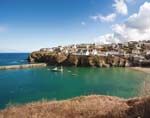National strategy required for coastal areas
Coastal areas must adapt to rising sea levels and extreme weather events, urges the National Trust

After a winter of violent storms and crashing waves, the National Trust is calling for a ‘clear, national strategy' to help coastal areas adapt to rising sea levels and extreme weather. The Trust's Simon Pryor says this winter has been a sharp reminder of the limited shelf life of ‘hard' sea defences and the question of whether ‘natural processes' should be given more space to work. ‘There is a natural inclination to defend the coastline with concrete, but our coastline is dynamic and the forces of nature that have formed it are part of its beauty,' he explains.
The charity's report, Shifting Shores, argues that more use of ‘soft' defences, such as marshes and sand dunes, could take the power out of storm surges. At Gower in South Wales, where a wall has prevented the sea from inundating farmland for centuries, the Trust is contemplating the long-term viability of keeping the sea out and whether it should return the area to salt marsh. Its report predicts that some 380 miles of coast, affecting 169 of its sites, could lose land to erosion in the next century and that 10% of this loss could stretch from 325ft to 650ft inland.
It maintains that, although national planning policy sets a good framework for councils to manage coastal change, ‘there is too little evidence that this framework is being reflected in local plans'. It says there should be ‘a clearer mechanism for people to find out if their home or business lies within a coastal erosion risk zone' and that it should be considered what assistance can be given to homes and businesses under threat ‘in lieu of investing large sums on renewing sea defences'.
However, according to the Wildlife Trusts, some threatened areas cannot be ‘rolled back' due to development pressures on the land behind. ‘There's no one-size-fits-all solution, although a move to greater use of "softer" solutions is critical,' suggests Paul Wilkinson. ‘There are some areas of coast where wild habitats such as saltmarsh are being squeezed against hard engineering structures, but other cases where the harder structures are actually helping to save fragile freshwater habitats that would otherwise be destroyed by the sea.'
* Follow Country Life magazine on Twitter
Sign up for the Country Life Newsletter
Exquisite houses, the beauty of Nature, and how to get the most from your life, straight to your inbox.
-
 Dawn Chorus: The world's highest property has a fittingly sky-high price
Dawn Chorus: The world's highest property has a fittingly sky-high priceOur daily round-up of news includes a flat that's 2,500 ft above the ground, our stop-you-in-your-tracks picture of the day, a chance to see two of Country Life's best-loved experts, and news about our Quiz of the Day.
By Toby Keel Published
-
 Brockfield Hall, the great Yorkshire house that's gone from Regency mansion to modern family home
Brockfield Hall, the great Yorkshire house that's gone from Regency mansion to modern family homeBrockfield Hall in North Yorkshire is the family home of Charlie Wood and Hatta Byng, editor of House & Garden, who have transformed it since they came here in 2020, winning multiple awards in the process. John Martin Robinson reports on the restoration project that revived this compact Regency house as a modern family home. Photographs by Paul Highnam for Country Life.
By John Martin Robinson Published